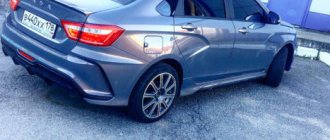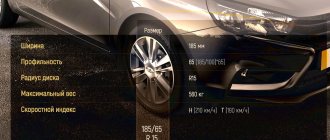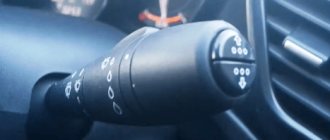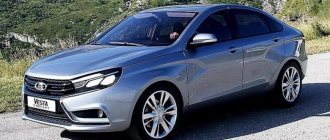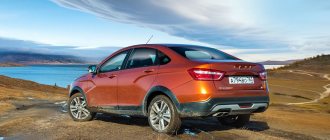In the fall of 2014, China officially introduced the ChanganAlsvin V7 sedan. Companies in the Middle Kingdom often use the appearance of famous cars and create clones of them. Moreover, the similarity is both superficial and almost complete. LADA Vesta was no exception. It is Alsvin v7 that gives the impression of her copy. The Chinese design of the car caused a storm of emotions, interest, and comments on this development. Later, the Changan company presented the Alsvin V7 model at MIAS in 2016. This model is a budget sedan, which in Russia sells from 609,000 rubles, which is very inexpensive for such a equipped car. The Chinese foreign car costs 100,000 rubles more than the Lada Vesta.
Differences between copies and frets of Vesta
Let us remind you that the design of the Lada Vesta sedan was created by a British specialist, Steve Mattin, who has been a designer at AvtoVAZ since 2011. The Chinese copy of the Lada Vesta has the maximum resemblance to the original at the rear, especially the shape of the lights. The taillights of the Chinese clone do not easily resemble Vesta, but completely duplicate them. There are similar elements in the interior design that look like Russian. From afar, the emblem on the hood of Changan looks like the VAZ logo.
When comparing these models from the front, differences are observed, which is not so categorical. Foreign manufacturers competing with AvtoVAZ could not leave the elegant design of the Lada Vesta unnoticed.
Let's take a closer look at the Changan Alsvin V7 and find out whether it is a great new product or a Chinese copy of the popular AvtoVAZ model.
Comfort comes first
Let's move on to a more important aspect - comfort in the cabin. Here again, the advantage can be given to Vesta, since the larger wheelbase and wide body profile provide the opportunity to create more free space for passengers.
Second row of seats Lada Vesta
In addition, the well-thought-out interior layout of the Russian new product, made according to European standards, also works for this. The Chinese are lagging behind, offering more cramped (especially in the second row) interiors.
When it comes to the quality of the interior, Vesta is again in the lead, since the problems with the smell of plastic in Chinese cars are known to everyone, plus the quality of the materials used for their finishing is also far from perfect.
Vesta interior elements
However, the leadership is still conditional, since no one has yet tested full-fledged production cars, and therefore the quality of assembly and interior decoration of the Lada Vesta has not yet been confirmed by practice.
Elegant body
The body of the Chinese Alswin B7 is emphasized by the unusual shape of the headlights. The chrome surround of the radiator grille visually increases the volume of the front and adds elegance. The taillights fit very well into the trunk lid and opening. The car has good aerodynamics, as it has streamlined, smooth lines along the body. Large rims indicate a powerful engine. The shapes of the bumpers further add to the similarity, but the rear window of the Alsvin V7 is slightly taller. When comparing the design of the sides, there is a different shape, but the same door embossing technology. The taillights on the fenders and the front bumpers are identical in contour. The same size of 16-wheel drives of the Chinese and Russian models is noticeable, which enhances the similarity.
Attractive dimensions
In this table you can compare the overall dimensions:
Model Lada Vesta Changan Alsvin V7
- Parameter(mm)
- Length 4410 4530
- Width 1764 1745
- Height 1497 1498
- Wheelbase 2635 2610
- Ground clearance 170 150
- Tire size 185/65R15195/55/R16 195/55/R15 195/50/R16
Alsvin V7 gains 12 centimeters in length, which is a significant difference, but is inferior in ground clearance. The original Lada Vestana is 2 centimeters higher. The remaining dimensions of these models are almost the same. The increased length provides the clone with a more comfortable rear seat for passengers. Perhaps when designing the AvtoVAZ car, this point was not taken into account.
Winning appearance
As usual, let's start with the appearance, because this is the most significant trump card of the VAZ new product. The X-DNA used in the design gives a clear advantage over Chinese sedans. None of them can boast of such a striking appearance, executed in a modern style. The only ones that stand out from the general monotonous mass are the Haima M3 and Brilliance H230, which received stylish head optics and aerodynamic contours with thoughtful stamping that serves not only a decorative purpose.
Haima M3
The exterior design of Chery Bonus 3, Geely GC6 and Dongfeng S30 is slightly worse. The excessively “straightforward” Lifan Solano New closes the list.
Lifan Solano New
Vesta also has an advantage in terms of available body color options. The colors of the Lada Vesta are represented by an impressive list of 12 shades, with most of them having a metallic effect. Moreover, in the future AvtoVAZ plans to expand this list to sizes that not only Chinese, but many European cars cannot boast of.
As for the overall dimensions, they can be compared in the table below. Note that the Russian sedan is a leader in terms of body height and width. It also has a longer wheelbase and also has the highest ground clearance. But in terms of luggage compartment capacity, the Lifan Solano has no equal; with other sedans, Vesta is approximately in the same weight category.
| Lada Vesta | Lifan Solano New | Haima M3 | Geely GC6 | Dongfeng S30 | Brilliance H230 | Chery Bonus 3 | |
| Body length (mm) | 4410 | 4450 | 4545 | 4342 | 4526 | 4390 | 4450 |
| Body width (mm) | 1764 | 1705 | 1737 | 1692 | 1740 | 1703 | 1748 |
| Body height (mm) | 1497 | 1495 | 1495 | 1435 | 1465 | 1482 | 1493 |
| Wheelbase (mm) | 2635 | 2605 | 2600 | 2502 | 2610 | 2570 | 2570 |
| Ground clearance (mm) | 171 | 150 | 160 | 150 | 150 | 114 | 151 |
| Trunk volume (l) | 480 | 650 | 450 | 468 | 487 | 500 | 450 |
Modest trunk
The trunk of Lada Vesta and Changan Alsvin V7 has a volume of 480/410 liters. The Chinese beauty received a reduced luggage compartment due to an increase in the length of the cabin. Although Chinese designers made the trunk small, it is nevertheless functional. The luggage compartment is trimmed with good quality fabric, and there is a window in the rear seat to accommodate long items in the cabin. The downside is the protruding arches on the rear wheels, which interfere with the transportation of large cargo, but the Lada Vesta has such an opportunity.
New Chinese crossover: in cost – Lada Vesta, in appearance – Hyundai Creta
Comparing the Brilliance V3 crossover with Lada Vesta and Mitsubishi ASX
Sales of the new Chinese crossover Brilliance V3 are starting in Russia. Despite its modern appearance and four good trim levels (we’ll talk about them in more detail below), the model is moderately priced. It's no joke, the Chinese crossover model is cheaper than the Lada Vesta, but has all the advantages of a full-fledged urban crossover like the Hyundai Creta!
It was announced that the minimum cost of a car starts from 839 thousand rubles. At the same time, the “ceiling” will cost 939 thousand rubles. That is, the top version will not cross the 1 million ruble mark, which can be considered an extremely advantageous offer on the market not only among crossovers, but even among modern domestic sedans. Again, let’s compare it with the Vesta model, which is the most technically suitable, which even at the minimum price costs from 600 thousand rubles, but in the top version it is slightly ahead of the Chinese crossover. Only for 1,000 rubles, but formally this is enough. At the same time, the “sports” version of the domestic sedan called “Sport” has already crossed this very psychological million-dollar threshold. The minimum cost of the latter corresponds to 1,021,900 rubles.
Perhaps the domestic car is better equipped compared to its Chinese price competitor? Maybe the quality of the “Chinese” is poor? Let's take a look at the new model from the Middle Kingdom and quickly compare it in some respects with the domestic sedan.*
*We understand that comparing a crossover to a sedan is incorrect. However, we also know that a modern urban crossover is just a standard passenger car with a raised suspension and a slightly increased ground clearance. Especially when it comes to single-wheel drive versions. Therefore, it is worth comparing such cars according to the parameters of the average person - that is, not according to driving characteristics, but according to the quality of comfort.
Brilliance V3 – a crossover costing less than 1 million rubles
The first thing I would like to note is that it is not the latest model in the Brilliance line that is coming to the Russian market, but a version from three years ago. That is, the 2016 model.
Secondly, the car does not look old or awkward. Probably, the chief designer, who had a hand in developing the prototype, helped with this. Dimitri Weisdomini previously worked at the famous coachbuilder Pininfarina, so he definitely has experience in creating attractive models.
Third, the crossover is compact in size. It is smaller than the Hyundai Creta, but at the same time it looks even more interesting than the updated Korean counterpart. Compactness in the city is a convenient thing (if there are two people in the car - the driver and a passenger sitting in the front seat), but for long trips, and even four people. It’s better to take the train.
The V3 model turned out to be even smaller than the small Japanese crossover Mitsubishi ASX (by 95 mm in length, 25 mm in height and as much as 100 mm in wheelbase). True, the “Chinese” is 20 mm wider, but this cannot compensate for the tiny internal dimensions of the cabin. If it’s terribly inconvenient to ride in the second seat in the ASX, even in the city, what will happen in the Brilliance model?
In comparison, the domestic sedan is much more thoughtful for everyday use, including for traveling long distances with the entire family.
The fourth is a 1.5 liter engine with a power of 107 hp. With. Not so great by modern standards. Nevertheless, with a manual, acceleration to 100 km/h will be 11.4 seconds, and the official consumption in the combined cycle will be around 7.5 liters. The engine is combined with classic types of gearboxes - 5-speed manual and automatic.
For comparison: the Lada Vesta in its initial configuration with a 1.6-liter engine with a capacity of 106 “horses” spends 11.2 seconds to 100 km/h and 6.9 liters/100 km, according to official measurements.
Fifth - at least the electronics are heaped up! Already in the initial configuration, the crossover has: Anti-lock braking system (ABS) Brake force distribution (EBD) Emergency braking assistance (EBA) Stability control (ESP) Traction control (ASR) Hill start assist (HHC) Control system tire pressure
For example, the same Japanese Mitsubishi 2022 model year in the middle “Intense” configuration has a limited set of safety options to three items: Anti-lock braking system (ABS) Brake force distribution (EBD) Emergency braking assistance (EBA)
But the Lada Vesta for 600 thousand rubles pleases with care for the owner, providing in the initial version similar system options as on the Chinese crossover, with the exception of the “Tire Pressure Monitoring System”.
In addition, air conditioning and heated power side mirrors are available for a minimal price on the V3. And also in more expensive versions (costing 879 and 939 thousand rubles, respectively) there is a parking assistance system, a rear view camera, a multifunction steering wheel, cruise control and a multimedia system with a 7-inch touchscreen.
Sixth - a car warranty of 5 years or 150 thousand km. Let us remind you that Lada provides a warranty of 3 years or 100,000 km.
So, who is the new cheap crossover for? As for us, this is a purely urban option for two people or a young family with a small child. It will be quite difficult to fully exploit such a little thing. However, for less than 1 million rubles you get a crossover, which means slightly more comfortable operation in winter and on very light off-road conditions. True, the monodrive is confusing. But the price tag makes up for this failure.
Nice salon
Of course, the Chinese interior is comfortable, very competitive in its class. At first glance, the interior of Changan Alsvin B7 makes a good impression. The finish attracts with its unusual design and quality of materials, but the plastic on the front panel is hard, and the door trim feels rough to the touch. The top model Alsvin V7 has a leather but light interior, which makes daily maintenance difficult. The multifunctional steering wheel is covered in leather and nicely decorated with chrome inserts. The multimedia control system, also installed on the steering wheel, is conveniently made. The Chinese sedan is equipped with a sunroof, power windows (equipped with electric drives), the head unit, located at the top of the front panel, has a retractable liquid crystal screen.
Engine - Blue Core
A copy of the Lada Vesta, for the Russian Federation, is produced with front-wheel drive, but the reasons for this fact are unclear. Equipped with a Blue Core 4-cylinder petrol engine mounted transversely. The Chinese Vesta has a 1.6-liter engine with a power of 113 horsepower. The internal combustion engine meets the Euro 5 standard for environmental friendliness and has a 5-speed manual or 4-speed automatic transmission. Main characteristics of Blue Core:
- volume – 1.6 l;
- type – in-line;
- cylinders – 4;
- number of valves per cylinder – 4;
- power – 113 l. With.;
- fuel type – AI-95;
- dynamics – 10.6 seconds;
- fuel consumption l/100 km (city/highway/mixed) – 8.5/7.5/8.0.
The power unit does not have powerful characteristics, but it can easily boast a consumption of 8.5 liters per 100 km, which is very attractive. The reliability and adaptability of the internal combustion engine to the road and climatic conditions of Russia can be judged after testing the Chinese sedan by Russian consumers.
Motor race
Chinese sedans are sold in Russia with only one powertrain option. In all cases, these are 4-cylinder in-line gasoline engines with a 16-valve timing belt and distributed injection.
Haima 3 engine
The domestic new product is more variable and will receive 4 engine options at once, but gradually. Initially, a modification with a 106-horsepower engine will appear on the market, which we conventionally accept as the “base” one.
Most likely, in terms of sales volumes, over time, its place will be taken by a 114-horsepower French-made unit. The youngest in the line will be an 87-horsepower engine, and the top-end will be a new 1.8-liter engine with an output of 123 horsepower, which is expected to appear next year.
Vesta also has higher variability in terms of gearboxes. There will be three of them: “mechanics”, “robot” and “variator”. The Chinese, at best, are ready to offer two classic options: “manual” and “automatic”. For a more visual comparison, we have compiled a table with all possible engine and gearbox options for the cars being compared.
AvtoVAZ's attitude to the copy of Lada Vesta
The president of the Russian concern, Nicolas More, has a positive attitude towards such “plagiarism”. Mor is glad that others have become interested in domestic developments and are copying them abroad. He considers this an excellent confirmation that the car has such an interesting design that companies are trying to imitate AvtoVAZ. Configurations of the copy “Changan Alsvin V7” are available in three configurations:
- Standard;
- Comfort;
- Luxe.
When comparing the equipment of Alsvin V7, two configurations are identical in name to Vesta (Comfort and Luxe). Transmission to choose from: manual or automatic.
The standard and comfort versions have heated seats, air conditioning and a pair of front airbags. Luxe version cars are equipped with an electric sunroof, a start button for starting and stopping the engine, an immobilizer, an electronic dynamic stabilization system, central locking and 4 airbags.
All three versions are equipped with a manual transmission, but Comfort and Luxe are also available with an automatic transmission.
Cross was also copied
China also released a crossover with an identical design to the Lada Vesta sedan and Xray hatchback. Landwind E36 copied not only the famous “X”, but left the same radiator grille. The shape of the headlights and bumper were also left unchanged. Landwind constantly “clones” other car brands, in search of its own design.
A front-wheel drive copy should soon appear in the Middle Kingdom. According to some reports, the SUV will be equipped with a turbocharged 1.5-liter gasoline engine and a naturally aspirated 1.6-liter engine. Power and torque have not yet been revealed.


